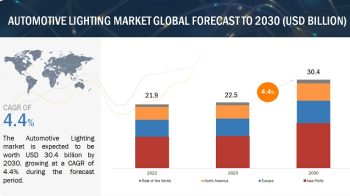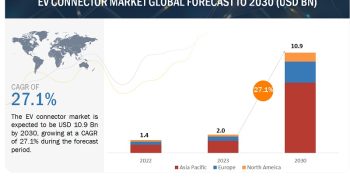
The automotive smart antenna module is a digital wireless communication system that can exhibit the diversity effect on components, namely, transmitter and receiver. The diversity effect refers to the transmission or reception of multiple band radio frequency (RF) waves at once to increase the data transfer rate between the source and the connected vehicle. The increasing demand for cellular applications will increase the number of connected cars, and hence, the demand for smart antennas.
MarketsandMarkets Expects the Global Automotive Smart Antenna Market to grow from USD 2.3 billion in 2018 to USD 5.9 billion by 2025, at a CAGR of 14.2% during the forecast period.
Opportunities:
• New Revenue Opportunities in the Autonomous Vehicle Ecosystem
• Significant Revenue Contribution From Premium Vehicle Sales
The advancements in automotive technologies are in a phase of development that holds great importance for the automotive industry in the coming years. The rapid evolution of complex electronic networks in vehicles is allowing interactions between a vehicle and mobile or static radio devices. The accelerated involvement of leading players and startups from the automotive and non-automotive industries to develop self-driving technologies is boosting the demand for robust communication hardware and software. This results in an increasing need for communication devices including antennas which are one of the most crucial parts of vehicles today. Additionally, the awareness of connectivity-based safety features among people in Europe has increased in the last decade. Also, the eCall mandate in Europe has boosted the connectivity concept, and companies are taking steps to provide innovative technologies.
The automotive smart antenna market comprises major solution providers such as Continental (Germany), Denso (Japan), TE Connectivity (Switzerland), Hella (Germany), Laird (UK), Yokowo (Japan), Harada (Japan), Schaffner (Switzerland), Kathrein (Germany), and Ficosa (Spain).
Download PDF Brochure @ https://www.marketsandmarkets.com/pdfdownloadNew.asp?id=29612374
The ultra-high frequency segment is expected to grow at the highest CAGR during the forecast period. The applications of ultra-high frequency are based on long-range communication. Applications such as satellite radio (SDARS), digital video broadcasting (DVB), cellular connectivity, WLAN, and V2V communication fall under ultra-high frequency. The ultra-high frequency is estimated to be the fastest segment owing to an increase in the number of connected cars. The connected car concept has brought the next growth cycle for the automotive industry with loads of convenience and safety features. These features are making the ultra-high frequency segment grow at the highest CAGR during the forecast period.
The commercial vehicle segment is expected to grow at the highest CAGR during the forecast period. The increasing transportation applications such as truck platooning, AI, and semi-autonomous and autonomous vehicles would fuel the growth of the smart antenna market for commercial vehicles. Also, logistics companies around the globe are making significant investments in building robust technology platforms such as onboard diagnostic systems, fuel management systems, and driver information systems (DIS). The adoption of these functions in the commercial vehicle segment is expected to fuel the demand for vehicle electronics, which, in turn, will provide an opportunity for the manufacturers of the automotive smart antenna module.
In terms of geographic coverage, the automotive smart antenna market has been segmented into 4 regions, namely, North America, Asia Pacific, Europe, and the Rest of the world (RoW). The row is expected to record the highest growth rate during the forecast period because of the increasing sales of premium vehicles in the region. With the increasing high disposable income of consumers, the demands have changed in line with their new lifestyle, leading to a change in their preferences. Factors such as increasing per capita income, improving infrastructure, and increasing competition between OEMs to offer improved features have also positively impacted the sales of premium passenger vehicles across the globe.
Request for Sample Pages @ https://www.marketsandmarkets.com/requestsampleNew.asp?id=29612374
Currently, vehicles are equipped with a variety of electronic components to sense the environment around and transmit and receive data through a smart antenna. OEMs and automotive Tier I suppliers along with non-automotive players are going to make autonomous vehicles possible. Hence, today’s vehicles are just in the initial stage of the autonomous vehicle era. The major automobile manufacturers have already announced their expected year, i.e., 2020, by which they are going to commercialize their autonomous vehicles in selected metro cities globally. Apart from OEMs and other players in the automotive ecosystem, governments are also taking steps to support autonomous vehicles. The regulatory bodies have already started to plan for new and disruptive transportation systems. Hence, companies are focusing on autonomous vehicles that call for reliable and robust multiband technology in smart antennas.
Recent Developments:
• In June 2018, Laird announced its new design center in Bucharest, Romania, to continue expanding the company’s global footprint and its leadership in automotive telematics, wireless in-vehicle charging, smartphone integration, and sophisticated antenna systems.
• In August 2017, TE Connectivity announced the complete acquisition of Germany-based Hirschmann Car Communication (HCC). The acquisition is a key growth strategy as it expands the product portfolio and enables the company to offer end-to-end data connectivity solutions for evolving connected and autonomous vehicles.
• In June 2017, Continental joined hands with Carnegie Technologies to expand its portfolio of holistic vehicle connectivity. The technology provides bandwidth aggregation and gapless handover of calls and data for faster speeds and seamless switching between different networks such as Wi-Fi, LTE, 3G, and satellite.


